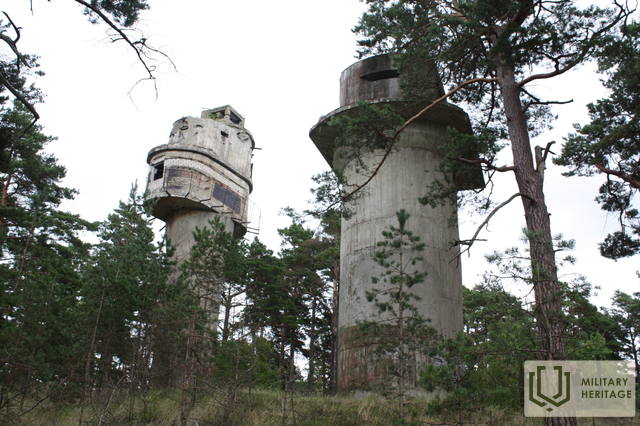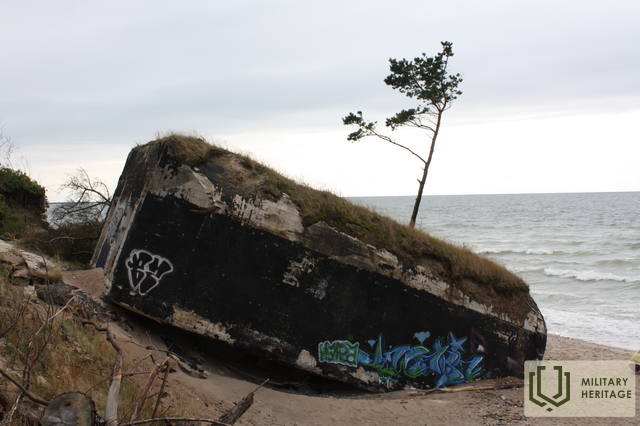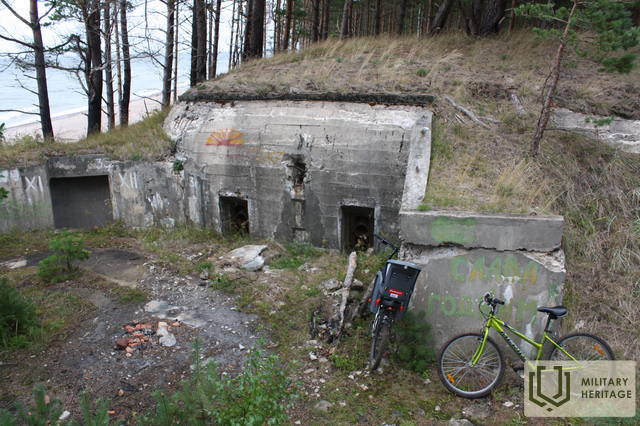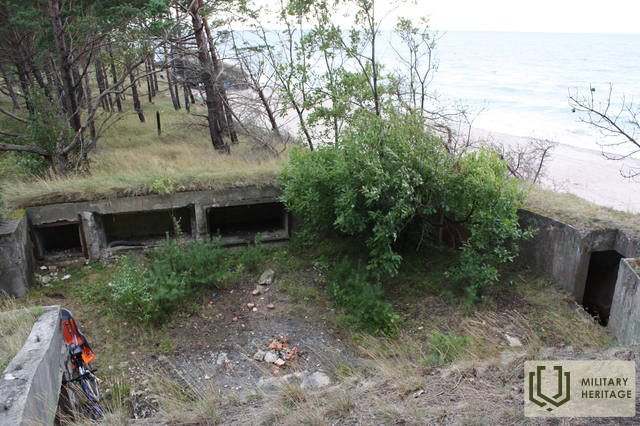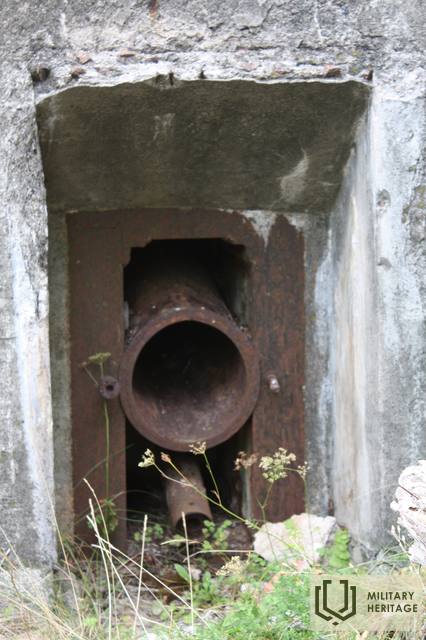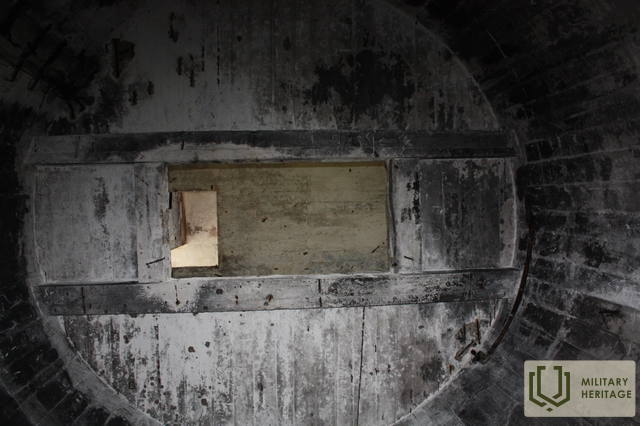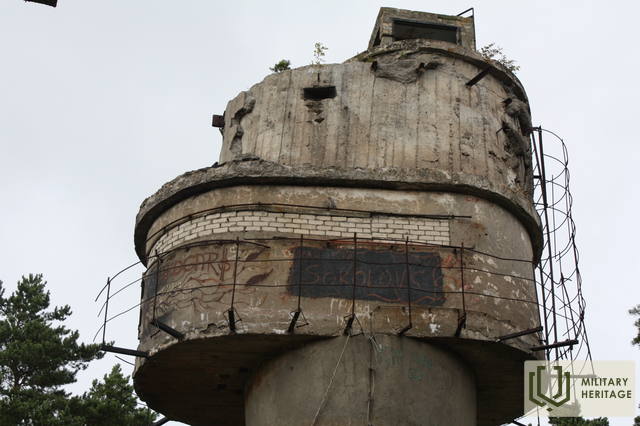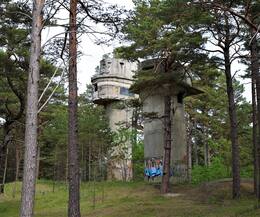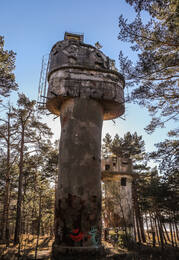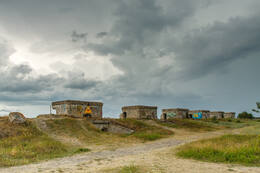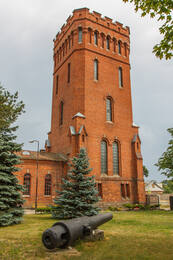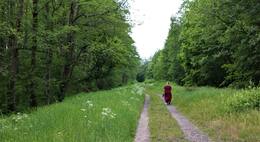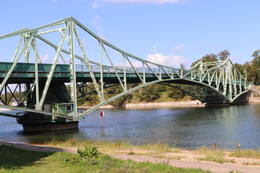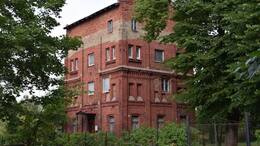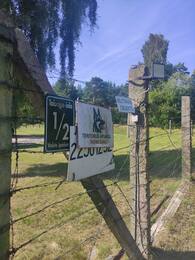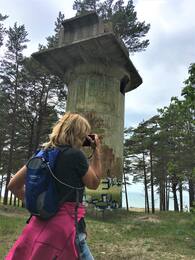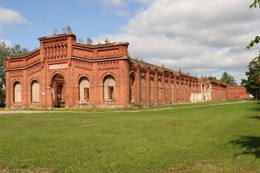Karostos unikalaus karinio objekto istorija
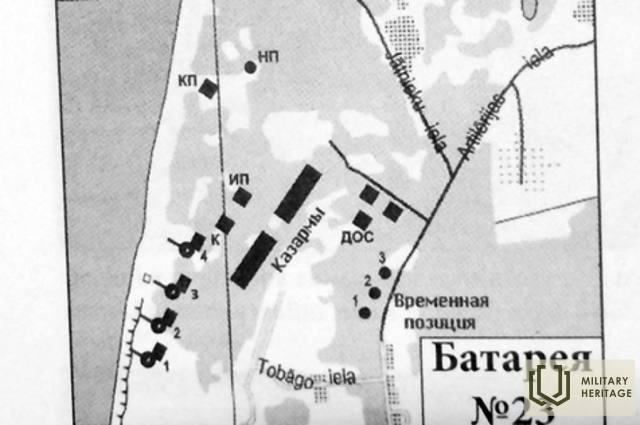
Jau daugelį metų nepastebėjau jokio nuolatinio Senosios Liepojos gyventojų susidomėjimo unikaliomis vietomis, esančiomis vos už aštuonių–dešimties kilometrų į šiaurę nuo miesto centro. Tačiau miško tankmėje, kopų šlaite ar pelkių takuose pasislėpusios istorinės Karostos vietos yra ne mažiau įdomūs istoriniai faktai ir istorijos, vertos seniai pamirštų legendų. Viena iš jų – buvusi 23-oji SSRS pakrantės artilerijos baterija – ir bus šio pasakojimo tema.
Kartu su 27-ąja pakrantės artilerijos baterija dabartinėje Pērkones Grīnvalti teritorijoje, SSRS kariuomenė taip pat pradėjo statyti galingas artilerijos pozicijas šiaurinėje Liepojos dalyje, Karostos, Tobago ir Jātnieku gatvių rajone. Šiandien tai liudija gerai išsilaikę tolimačio bokštai, požeminis vadavietės postas, betoniniai sandėlių rūsiai, ryšių centro ir gaisrų gesinimo baseino kontūrai. Keturios betoninės 130 mm kalibro jūrų pabūklų pozicijos mažiausiai atlaikė laiko žalą ir pakrantės eroziją.
Kaip svarbu ir skubu buvo „ribotam“ Rusijos sovietų kontingentui Latvijos Respublikoje čia dislokuoti sunkiuosius pabūklus, galite patys įsitikinti ėję Lībiešu gatve Šķēdes dārzeņu kryptimi – kairėje plento pusėje, kuri vis dar iš dalies užpelkėjusi ir apaugusi alksniais, vis dar galima pamatyti laikinas 23-iosios baterijos pozicijas. Jų apkasai – pylimai trims pabūklams ant medinių vežimų – pirmą kartą buvo pastatyti per 1939 m. rudens šalnas. Pabūklų įgulos, turėjusios miegoti palapinėse, savo kovinę budėjimą pradėjo 1939 m. lapkričio pabaigoje.
„Tikrosios“ baterijos statyba prasidėjo 1940 m. sausį. Pirmieji objektai buvo vadinamosios inžinerinės pozicijos – dyzelinė elektrinė, šilumos magistralės, medinės rąstinės kareivinės, sanitarinės kareivinės, skalbykla ir katilinė, tačiau buvusios carinės baterijos Nr. 2 pietiniame pakraštyje taip pat buvo išbetonuotas ir šarvuota plienine „kepure“ uždengtas vadavietės postas. 1940 m. gegužę, kai kopose buvo lyginamas kelio trasa sunkiems kroviniams gabenti, apie 300 kareivių pradėjo betonuoti patrankų pozicijas ir požemines galerijas. Savaime suprantama, visus darbus akylai stebėjo NKVD ir vietos ūkininkai iš Šķēdės ir Medzės parapijų, kurie dirbo atveždami akmenis ir žvyrą, ir jiems ten nebuvo leista įeiti – čekistas paėmė vežimo vadeles ir įvažiavo už spygliuotos vielos tvoros, nereikia trinti pūslių į nepažįstamųjų akis!*
Tačiau joks adatos slėpimas maišelyje negalėjo sustabdyti gandų, kad tam tikras betonuotojas buvo svetimas darbininkų klasei ir aplaidžiai pažeidė nepertraukiamo betono liejimo procesą. Žinoma, piktadarys buvo nušautas.
Medzės gyventojas, tada dar berniukas, neseniai man papasakojo apie gana keistus nuotykius statant bateriją: „Važiavome rogėmis į Liepojos turgų, ir netoli „Žvaigznės“ išgirdome pragarišką triukšmą. Iš Škėdės pusės keliu riedėjo dundesiu ir dūmais didžiulis vikšrinis traktorius, tempdamas ant dviejų rąstų pastatytas milžiniškas roges. Jose buvo sukrauti akmenys iš Medzės karjerų. Netoliese vaikščiojo arba sėdėjo ant „rogių“, rusų kareiviai, bet ant akmeninio vežimo, tarsi soste sėdėtų, buvo vyras su „garmoška“**.“
23-ioji baterija buvo pradėta eksploatuoti 1941 m. gegužės 5 d., o gegužės 17 d. įgula, 180 žmonių, pradėjo kovinę tarnybą.
1941 m. birželio mūšių metu baterijos vadui kapitonui Gordeičukui pavyko perkelti pabūklus šaudyti prieš puolančius vokiečius Grobinios-Brēdikų rajone. Birželio 27 d. pabūklai buvo susprogdinti.
Dabar buvusios baterijos, artilerijos tolimačio bokštų, patrankų aikštelių, požeminių galerijų ir vadavietės liekanos yra užmiršti ir niūrūs objektai, tačiau, mano nuomone, jie išlaikė liūdnos istorijos aurą.
*Glaza mazolitya – rusiškas posakis – pasislėpti nuo smalsių akių.
**Armonika.** Muzikos instrumentas – dumplinė armonika.
https://irliepaja.lv/vide/stasts-par-unikalu-militaru-objektu-karosta/
Susijusi laiko juosta
Susijusios temos
Susijusios vietos
Liepojos pakrantės gynybos baterija 23
Baterija yra tarp Tobago ir Marine gatvių, jūros link.
Pagal 1939 m. spalio 5 d. pasirašytą Latvijos Respublikos ir SSRS „bazių sutartį“, Kuržemėje turėjo būti dislokuotas beveik 25 000 Raudonosios armijos ir Baltijos karių kontingentas. Iki 1941 m. kovo mėn. Latvijoje, Irbės įlankos, Saremos ir Liepojos gynybos sektoriuose, buvo įkurtos Baltijos šalių karinio jūrų laivyno bazės, kurias sudarė pakrantės gynybos baterijos.
Liepojos pakrantės gynybos sektorių sudarė 208-oji artilerijos divizija su dviem 130 mm B-13 patrankų baterijomis (Nr. 23 ir Nr. 27) ir viena 180 mm bėginių patrankų baterija. 23-iosios baterijos statyba prasidėjo 1939 m. lapkritį ir buvo baigta 1941 m. gegužės 17 d., iš dalies panaudojant Liepojos tvirtovės 2-osios baterijos gelžbetoninius įtvirtinimus. 23-iąją bateriją sudarė keturios gelžbetoninės patrankų pozicijos pakrantėje, vadovavimo postas ir stebėjimo (atstumo matavimo) bokštas kopų miške. Atstumo matavimo pozicijos buvo išdėstytos gelžbetoniniuose bokštuose, siekiant užtikrinti geresnį matomumą ir kartu išlaikant paslėptą vietą pušyne.
1 ir 2 patrankų pozicijos yra pajūryje ir iš dalies eroduotos, o 4 patrankų pozicija geriausiai matoma kopose. 23-iąją bateriją 1941 m. birželio 27 d. susprogdino sovietų kareiviai, traukiantis iš Liepojos.
Po Antrojo pasaulinio karo 23-ioji baterija buvo pervadinta į 636-ąją ir ginkluota tais pačiais 130 mm B-13 pabūklais, tačiau 1954 m., greta 1941 m. bokšto, ugnies valdymui buvo pastatytas naujas šaudymo bokštas. 1963 m. buvo išardytos visos Liepojos pakrantės gynybos pabūklai.
Atkūrus Latvijos nepriklausomybę, 2-osios baterijos rajonas priklauso Gynybos ministerijai.
Du bokštai yra labai arti vienas kito – vos 10 m atstumu. Keturios pabūklų pozicijos buvo išdėstytos dešinėje nuo abiejų bokštų, iš tikrųjų pakrantėje. Pabūklus aptarnavusių personalo gelžbetoninis bunkeris dabar nuplaunamas bangų ir turi išplautus pamatus, pasvirusius ir pasvirusius į jūrą.
Karosta, Liepojos karinis uostas (ekskursija)
Karosta yra didžiausia istorinė karinė teritorija Baltijos šalyse ir užima beveik trečdalį visos Liepojos teritorijos. Karosta – unikalus karinių ir įtvirtinimų pastatų kompleksas Baltijos jūros pakrantėje, turintis ypatingą reikšmę Latvijos ir pasaulio istorijoje bei architektūroje. Karostoje yra tokie karinio paveldo objektai kaip Šiaurinis molas ir fortai, Redanas, Karostos kalėjimas, Karostos vandens bokštas, Šv. Nikolajaus stačiatikių Jūros katedra, Oskaro Kalpako tiltas ir kiti.
Liepojos šiaurinis fortas ir 1-oji baterija Karostoje
Šiauriniai fortai yra geriausiai žinoma ir vizualiai įspūdingiausia Liepojos tvirtovės dalis. Juos XIX a. pabaigoje pastatė Rusijos caro armija, o istorinis jų pavadinimas – 1-oji tvirtovės baterija.
1908 m. lapkritį, praėjus mažiau nei 10 metų po Liepojos tvirtovės pastatymo, ji nustojo veikti, nes jos statyba buvo pripažinta strategine klaida. Dalis patrankų buvo išardytos ir išvežtos į Kauno tvirtovę Lietuvoje, o kitos – išlydytos. Fortifikaciniai statiniai buvo du kartus susprogdinti, siekiant sunaikinti įtvirtinimus. Iki šių dienų išlikusios detalės yra sprogimų metu nevisiškai sunaikintos artilerijos baterijos ir požeminiai statiniai. Kaip ir Karosta, Šiauriniai fortai sovietų okupacijos metu buvo uždara karinė teritorija. Šiaurinių fortų lankytojai turėtų būti labai atsargūs. Kaip ir kitose Latvijos pakrantės vietose, status Baltijos jūros krantas Karostoje yra pavojingas dėl galimų pakrantės nuošliaužų. Todėl po fortų griuvėsiais vaikščioti draudžiama.
Šiaurinėje tvirtovės dalyje buvo įsikūrusi viena iš keturių pakrantės gynybos baterijų – 1-oji baterija. Baterijoje turėjo būti šešios 6 colių (152 mm) 1892 m. modelio „Canet“ sistemos patrankos, šešios 11 colių (280 mm) 1887 m. modelio patrankos ir dvi 57 mm „Nordenfeld“ priešlaivinės patrankos. Tik „Canet“ sistemos patrankos turėjo pakankamai ilgą šaudymo nuotolį, kad atlaikytų galimą Vokietijos karinio jūrų laivyno apšaudymą. Taigi, likviduojant tvirtovę, ginkluotė buvo sumontuota tik iš dalies.
Karostos vandens bokštas
Vandens bokštas yra Liepojoje, Karostoje, Generolo Baložos gatvėje 29 – ten, kur gatvė susikerta su Lazaretes gatve. Vandens bokštas buvo svarbus Karostos statinys, nes tiekdavo geriamąjį vandenį beveik visai Karostos teritorijai. Tikslus vandens bokšto statybos laikas nežinomas, tačiau jis galėjo būti pastatytas 1903–1905 metais. Projektą greičiausiai parengė Sankt Peterburgo architektas Stefanas Galenzovskis.
Vandens bokštą varė garo variklis su dviem anglimi kūrenamais katilais, vienas iš jų buvo laikomas rezerve, todėl šalia bokšto yra tokio pat aukščio kaminas. Transmisija varė keturis siurblius, iš kurių du buvo laikomi rezerve. Keturi gręžiniai tiekdavo vandenį siurbliams, kurie pumpuodavo jį į rezervuarą penktame bokšto aukšte, o iš ten – į karininkų butus ir kareivinių kareivines Karostoje.
Latvijos armijai perėmus vandens bokšto valdymą, vandens bokšto valdymą perėmė ir Karo ministerija. Po Antrojo pasaulinio karo valdymą perėmė Sovietų armija. Vandens bokštas uždarytas nuo 1989 m.
Nors bokštas nebuvo karinis statinys, 1919 m. lapkritį Latvijos armija atitaisė britų karo laivų artilerijos ugnį kovoje su Bermonto kariuomenės puolimu.
https://industrialheritage.travel/lv/objects/karostas-udenstornis/51
Laisvės takas (Karostos maršrutas)
Gerai prižiūrimas 9 km ilgio pėsčiųjų takas, sukurtas Latvijos vyrų drąsai ir didvyriškumui atminti 1919 m. Latvijos laisvės kovos metu.
Takas prasideda Redanoje ir driekiasi per Karostos miškų teritoriją, pajūriu ir Cietokšnios kanalu, aplankant caro laikų įtvirtinimus ir sovietmečio karinį paveldą. Take yra 5 informaciniai stendai, kuriuose supažindinama su Karostos ir visą miestą juosiančios įtvirtinimų sistemos sukūrimu, 1919 m. Liepojos Laisvės mūšiais, vėlesniais metais pastatytais kariniais statiniais ir gyvenimu Karostoje sovietmečiu.
1918 m. lapkričio 18 d. buvo paskelbta nepriklausoma Latvijos Respublika, tačiau naujai įkurtos Latvijos valstybės teritorijoje vis dar buvo dislokuoti keli užsienio kariai.
1919 m. lapkritį įvykęs Liepojos mūšis suvaidino svarbų vaidmenį atgaunant Latvijos laisvę, kai karių didvyriškumo dėka priešas buvo pralaimėtas beveik 5 kartus. Po lemiamų mūšių Liepojoje Bermontas buvo išvarytas iš Latvijos.
Oskaro Kalpako tiltas Karostoje
Oskaro Kalpakos vardu pavadintas tiltas yra Liepojos vartai į Karostą ir yra Oskaro Kalpakos ir Atmodos gatvių sankryžoje – kitoje Karostos kanalo pusėje.
Unikalus pasukamasis tiltas buvo atidarytas 1906 m. rugpjūčio 19 d. Tiltas buvo susprogdintas Pirmojo pasaulinio karo metu, tačiau po karo atstatytas. Tiltas buvo atstatytas po to, kai 1926 m. jį apgadino garlaivis „Narne“, tačiau jis nukentėjo ir Antrojo pasaulinio karo metu, kai įsiveržusi sovietų armija apšaudė Liepojos uostą. Iki Latvijos Respublikos nepriklausomybės atkūrimo Karosta buvo uždara Liepojos teritorija, neprieinama net Liepojos gyventojams. Visa Karosta buvo karinis objektas, todėl eismą per tiltą visą parą kontroliavo sargybos postai. Pereiti per tiltą į Karostą buvo galima tik gavus specialius leidimus kelias valandas per dieną, likusį laiką tiltas buvo atviras sovietinių karo laivų eismui. Visus okupacijos metus tiltas buvo vadinamas „Raudonosios armijos tiltu“. 2006 m. vasarą į šiaurinę tilto atramą įskrido tanklaivis su Gruzijos vėliava „Anna“, o po rekonstrukcijos Oskaro Kalpakos tiltas oficialiai atidarytas 2009 m. rugpjūtį.
Tiltas sveria 300 tonų ir susideda iš dviejų dalių (šiaurinės ir pietinės pusių), pagamintų iš dviejų identiškų konsolių. Tilto važiuojamosios dalies plotis yra 7,3 metro, o platforma – iš medinių lentų. Bendras tilto ilgis – 133 metrai, o tarpatramis – 27,55 metro + 77,9 metro + 27,55 metro. Tilto aukštis virš vandens lygio – 8,32 metro. Tiltas kertamas nustatytu laiku, ir, vadovaujantis Uosto saugos taisyklėmis, laivas gali pradėti eismą tik tada, kai tiltas yra atidarytas laivų eismui ir yra saugu įplaukti į Karostos kanalą arba išplaukti iš jo. Oskaro Kalpakos tiltas laivų eismui grąžinamas 5 kartus per dieną. Tiltas nustatytu laiku nekertamas, jei vėjo greitis viršija 10 m/s arba jei neplanuojami manevrai.
23-iosios Kranto baterijos antrasis tolimatis (1954 m.)
Tolimatis (datuojamas 1954 m.) yra kopos pušyse, 10 m atstumu nuo 1941 m. tolimačio. Kranto baterijos 1-ojo ir 2-ojo patrankų pozicijos yra pakrantėje ir iš dalies eroduotos, o 4-ojo patrankos pozicija geriausiai matoma kopose.
Liepojos tvirtovės 2-oji baterija buvo planuojama statyti toliau nuo kranto linijos ir apsaugoti aukštu pylimu. Baterijos ginkluotė turėjo būti 16 11 colių (280 mm) minosvaidžių, pagamintų 1877 m. modelio. Minosvaidžiai turėjo taikyti stačias trajektorijas ir nereikalavo tiesioginio taikymo.
Pagal 1939 m. spalio 5 d. pasirašytą Latvijos Respublikos ir SSRS „bazių susitarimą“, Kuržemėje turėjo būti dislokuotas beveik 25 000 Raudonosios armijos ir Baltijos karinio jūrų laivyno karių kontingentas. Iki 1941 m. kovo mėn. Latvijoje, Irbės įlankos, Saremos ir Liepojos gynybos sektoriuose, buvo įkurtos Baltijos šalių karinio jūrų laivyno bazės, kurias sudarė pakrantės gynybos baterijos.
Liepojos pakrantės gynybos sektorių sudarė 208-oji artilerijos divizija su dviem 130 mm B-13 patrankų baterijomis (Nr. 23 ir Nr. 27) ir viena 180 mm bėginių patrankų baterija. 23-iosios baterijos statyba prasidėjo 1939 m. lapkritį ir buvo baigta 1941 m. gegužės 17 d., iš dalies panaudojant Liepojos tvirtovės 2-osios baterijos gelžbetoninius įtvirtinimus. 23-iąją bateriją sudarė keturios gelžbetoninės patrankų pozicijos pakrantėje, vadovavimo postas ir stebėjimo (atstumo matavimo) bokštas kopų miške. Atstumo matavimo pozicijos buvo išdėstytos gelžbetoniniuose bokštuose, siekiant užtikrinti geresnį matomumą ir kartu išlaikant paslėptą vietą pušyne.
Po Antrojo pasaulinio karo 23-ioji baterija buvo pervadinta į 636-ąją ir ginkluota tais pačiais 130 mm B-13 pabūklais, o 1954 m., greta 1941 m. bokšto, ugnies valdymui buvo pastatytas naujas šaudymo bokštas. 1963 m. buvo išardytos visos Liepojos pakrantės gynybos pabūklai.
Atkūrus Latvijos nepriklausomybę, 2-osios baterijos rajonas priklauso Gynybos ministerijai.
Karvelių pašto jūrų stotis Karostoje
Buvusi karinio jūrų laivyno balandžių stotis Nr. 2 – iš tikrųjų veisimo stotis – yra Karostoje, Pulkveža Brieža gatvėje 6. Ji buvo pastatyta 1899–1900 m. ir buvo skirta apgyvendinti apie 450 pašto balandžių – sparnuotųjų karių. Vėlesniais metais pastatas buvo pertvarkytas į butus, todėl išliko tik raudonų plytų pastato korpusas. Kita pašto balandžių stotis, Nr. 1, kuri neišliko, buvo skirta 750 sausumos karių naudojimui ir buvo įsikūrusi Atmodas bulvaro šiauriniame gale.
Pašto balandžiai buvo paprastas, greitas ir patikimas būdas užtikrinti ryšį tarp kranto ir laivų jūroje. Nors radijo telegrafas, kaip moderni ryšio priemonė, tuo metu jau buvo plačiai naudojamas, balandžių naudojimas buvo laikomas saugesniu – priešas galėjo perimti pranešimą tik perimdamas patį pašto balandį. Pašto balandžiai judėjo vidutiniu 60 km per valandą greičiu, tačiau palankiomis vėjo sąlygomis jie galėjo judėti iki 100 km per valandą greičiu. Balandžius reikėjo specialiai paruošti ir apmokyti, todėl su jais elgtis reikėjo atsargiai ir kantrybės. Pašto balandžio ryšys veikė per paukščių gebėjimą grįžti į savo namų narvelį. Kai paukštis buvo perkeltas į kitą vietą – balandžių stotį, paleidimo ir paleidimo punktą – ir paleistas su pranešimų kapsule, mažasis pasiuntinys grįždavo į savo namų narvelį. Siekiant užtikrinti ryšį tarp dviejų balandžių stočių, kiekvienoje reikėjo laikyti tam tikrą skaičių paukščių, kurie buvo užaugę korespondento ryšio, arba pašto balandžių, stotyje. Kiekvienais metais balandžiai dalyvaudavo įvairiuose manevruose ir varžybose. Taip pat po Latvijos nepriklausomybės, nuo 1920 iki 1940 m., Liepojoje buvo įsikūrusi Latvijos armijos Kuršo divizijos pašto balandžių stotis, kuri galėjo susisiekti tiek su Ryga, tiek su Daugpiliu. Tarpukariu į Latvijos teritoriją taip pat atklydo pašto balandžiai iš Vokietijos, Lenkijos, Lietuvos, Suomijos ir Estijos. Balandžiai iš Latvijos staiga buvo aptikti ir kaimyninėse šalyse.
Pastatas per daugelį metų buvo kelis kartus perstatytas ir dabar yra gyvenamasis pastatas. Tačiau išskirtinė pastato forma, pastatyta iš raudonų plytų, būdingų seniesiems Karostos pastatams, vis dar aiškiai matoma iš išorės.
Liepojos pakrantės artilerijos baterija Nr.2
Tarp daugelio Liepojos jūrų muziejaus eksponatų, Liepojos pakrantės artilerijos baterija Nr. 2 iki šiol yra paslaptingiausia vieta Liepojoje. Antrojoje baterijoje visada buvo įrengti įvairių valstybių karių šaudmenų sandėliai.
Liepojos tvirtovės 2-oji baterija buvo pastatyta toliau nuo pakrantės ir buvo apsaugota aukšta įtvirtinimų siena. Baterija buvo ginkluota 16 11 colių (280 mm) minosvaidžių, pagamintų 1877 m. modelio. Išardžius tvirtovę, čia buvo įrengti šaudmenų sandėliai. Dėl sprogimo pavojaus teritorija 130 metų buvo uždaryta visuomenei, saugoma, tačiau dabar čia įrengta paroda apie 1-ojo Kuršo divizijos štabo veiklą 1919–1940 m., taip pat eksponuojami 1-ojo Liepojos pėstininkų pulko, 2-ojo Ventspilio pėstininkų pulko ir Kuršo artilerijos pulko fotografiniai įrodymai.
23-iosios Kranto baterijos pirmasis tolimatis (1941 m.)
Tolimačiai (datuojami 1941 m.) yra kopos pušyse, vos už 10 m nuo kito bokšto, pastatyto 1954 m. Kranto baterijos 1-oji ir 2-oji patrankų pozicijos yra pajūryje ir iš dalies eroduotos, o 4-oji patrankų pozicija geriausiai matoma kopose. Pabūklus aptarnavusių personalo gelžbetoninis bunkeris dabar nuplautas bangų ir turi išplautus pamatus, pasvirusius ir pasvirusius į jūrą.
Liepojos tvirtovės 2-oji baterija buvo planuojama statyti toliau nuo kranto linijos ir apsaugoti aukštu pylimu. Baterijos ginkluotė turėjo būti 16 11 colių (280 mm) minosvaidžių, pagamintų 1877 m. modelio. Minosvaidžiai turėjo taikyti stačias trajektorijas ir nereikalavo tiesioginio taikymo.
Pagal 1939 m. spalio 5 d. pasirašytą Latvijos Respublikos ir SSRS „bazių susitarimą“, Kuržemėje turėjo būti dislokuotas beveik 25 000 Raudonosios armijos ir Baltijos karinio jūrų laivyno karių kontingentas. Iki 1941 m. kovo mėn. Latvijoje, Irbės įlankos, Saremos ir Liepojos gynybos sektoriuose, buvo įkurtos Baltijos šalių karinio jūrų laivyno bazės, kurias sudarė pakrantės gynybos baterijos.
Liepojos pakrantės gynybos sektorių sudarė 208-oji artilerijos divizija su dviem 130 mm B-13 patrankų baterijomis (Nr. 23 ir Nr. 27) ir viena 180 mm bėginių patrankų baterija. 23-iosios baterijos statyba prasidėjo 1939 m. lapkritį ir buvo baigta 1941 m. gegužės 17 d., iš dalies panaudojant Liepojos tvirtovės 2-osios baterijos gelžbetoninius įtvirtinimus. 23-iąją bateriją sudarė keturios gelžbetoninės patrankų pozicijos pakrantėje, vadovavimo postas ir stebėjimo (atstumo matavimo) bokštas kopų miške. Atstumo matavimo pozicijos buvo išdėstytos gelžbetoniniuose bokštuose, siekiant užtikrinti geresnį matomumą ir kartu išlaikant paslėptą vietą pušyne.
Po Antrojo pasaulinio karo 23-ioji baterija buvo pervadinta į 636-ąją ir ginkluota tais pačiais 130 mm B-13 pabūklais, o 1954 m., greta 1941 m. bokšto, ugnies valdymui buvo pastatytas naujas šaudymo bokštas. 1963 m. buvo išardytos visos Liepojos pakrantės gynybos pabūklai.
Atkūrus Latvijos nepriklausomybę, 2-osios baterijos rajonas priklauso Gynybos ministerijai.
Karaostos manevras
Karostos maniežo griuvėsiai yra Karostoje, Žemgales gatvėje 2/12, tarp Zemgales, Burtnieku, Virssardzes ir Manēžas gatvių.
Iki Pirmojo pasaulinio karo kiekvieną sekmadienį manieže vykdavo kavalerijos, artilerijos ir vyresniųjų karininkų sportinių žirgų demonstracijos, o darbo dienomis – vyresniųjų karininkų kūno kultūros pamokos. Tai buvo didžiausia dengta salė Liepojoje, todėl joje taip pat vykdavo oficialūs priėmimai ir garbės pietūs garnizono vyresniosioms karininkėms. 1913 m., nuo sausio 13 d. iki balandžio 26 d., visoje Rusijoje buvo švenčiamos carų Romanovų dinastijos 300-osios valdymo metinės. 1913 m. vasario 21 d. pagrindinis šventės renginys buvo surengtas Liepojos garnizone, o abiejuose karininkų susirinkimų pastatuose (Karinio jūrų laivyno ir pėstininkų) vyko balius. Manieže karininkams buvo surengti šventiniai pietūs, kuriuose vienu metu prie stalų sėdėjo 4000 žmonių.
Manežas buvo statomas 1903–1904 m. Išskirtinis jo bruožas buvo stogas – labai lengvas, su kniedėmis pritvirtinta metaline konstrukcija, skardos danga ir stiklo čerpių juostelėmis. Kartu su didžiuliais arkiniais langais jis į patalpą patekdavo daug šviesos. Salė buvo asketiška – grindys buvo padengtos pjuvenomis. Manežas nukentėjo per Antrąjį pasaulinį karą, kai sudegė visa stogo konstrukcija. Po karo sovietų armija areną pradėjo naudoti kaip automobilių stovėjimo aikštelę ir sandėlį.
Šiandien matyti tik maniežo sienos, kurių langų angos sovietiniais metais užmūrytos.




